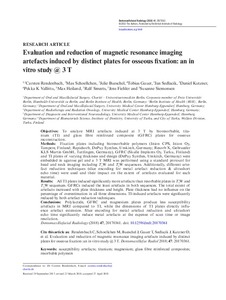Evaluation and reduction of magnetic resonance imaging artefacts induced by distinct plates for osseous fixation: an in vitro study @ 3 T
Kutzner D; Bueschel J; Vallittu PK; Rendenbach C; Fiehler J; Heiland M; Siemonsen S; Schoellchen M; Gauer T; Sedlacik J; Smeets R
Evaluation and reduction of magnetic resonance imaging artefacts induced by distinct plates for osseous fixation: an in vitro study @ 3 T
Kutzner D
Bueschel J
Vallittu PK
Rendenbach C
Fiehler J
Heiland M
Siemonsen S
Schoellchen M
Gauer T
Sedlacik J
Smeets R
BRITISH INST RADIOLOGY
Julkaisun pysyvä osoite on:
https://urn.fi/URN:NBN:fi-fe2021042719844
https://urn.fi/URN:NBN:fi-fe2021042719844
Tiivistelmä
Objectives: To analyze MRI artefacts induced at 3 T by bioresorbable, titanium (TI) and glass fibre reinforced composite (GFRC) plates for osseous reconstruction.Methods: Fixation plates including bioresorbable polymers (Inion CPS, Inion Oy, Tampere, Finland; Rapidsorb, DePuy Synthes, Umkirch, Germany; Resorb X, Gebrueder KLS Martin GmbH, Tuttlingen, Germany), GFRC (Skulle Implants Oy, Turku, Finland) and TI plates of varying thickness and design (DePuy Synthes, Umkirch, Germany) were embedded in agarose gel and a 3 T MRI was performed using a standard protocol for head and neck imaging including T1W and T2W sequences. Additionally, different artefact reduction techniques (slice encoding for metal artefact reduction & ultrashort echo time) were used and their impact on the extent of artefacts evaluated for each material.Results: All TI plates induced significantly more artefacts than resorbable plates in T1W and T2W sequences. GFRCs induced the least artefacts in both sequences. The total extent of artefacts increased with plate thickness and height. Plate thickness had no influence on the percentage of overestimation in all three dimensions. TI-induced artefacts were significantly reduced by both artefact reduction techniques.Conclusions: Polylactide, GFRC and magnesium plates produce less susceptibility artefacts in MRI compared to TI, while the dimensions of TI plates directly influence artefact extension. Slice encoding for metal artefact reduction and ultrashort echo time significantly reduce metal artefacts at the expense of scan time or image resolution.
Kokoelmat
- Rinnakkaistallenteet [19218]
